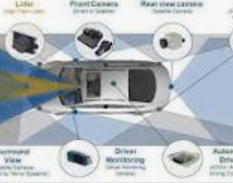
How AI Is Paving the Way for Autonomous Driving Vehicles in India

Introduction about Autonomous Driving Vehicles in India
India, a country known for its bustling streets and diverse traffic conditions, is experiencing a transformation in its transportation landscape. The emergence of autonomous driving vehicles, powered by artificial intelligence (AI), is changing the way Indians commute and the future of the automotive industry. In this article, we will explore how AI is paving the way for autonomous vehicles in India, addressing the opportunities, challenges, and the potential impact on the nation’s transportation ecosystem.
The Promise of Autonomous Driving Vehicles
What Are Autonomous Vehicles?
Autonomous vehicles, commonly referred to as self-driving or driverless cars, are vehicles equipped with advanced sensors, cameras, radar, and AI algorithms that enable them to navigate, make decisions, and drive safely without human intervention. They have the potential to reduce accidents, ease traffic congestion, and improve transportation efficiency.
Levels of Autonomy
Autonomous vehicles are categorized into five levels, from Level 0 (no automation) to Level 5 (full automation). Many current vehicles are at Levels 1 and 2, providing features like adaptive cruise control and lane-keeping assistance. Fully autonomous vehicles (Level 5) are still in the development phase.
AI’s Role in Autonomous Driving
Perception, Prediction, and Planning
AI is the brain behind autonomous vehicles, responsible for their perception, prediction, and planning capabilities:
- Perception: AI processes data from sensors, cameras, and lidar to identify objects, road signs, and traffic signals.
- Prediction: AI algorithms predict the future positions and behaviors of other road users, making decisions based on this information.
- Planning: AI plans the vehicle’s path and controls acceleration, braking, and steering to navigate safely.
The AI in Autonomous Vehicles
1. Machine Learning and Perception:
AI-powered self-using vehicles depend heavily on device mastering algorithms to understand and interpret their environment. Cameras, LiDAR sensors, radar, and other sensors gather enormous quantities of statistics, which AI structures process in real-time to make riding selections. In India, wherein avenue conditions and traffic may be chaotic, AI’s capability to evolve to dynamic environments is vital.
2. Advanced Driver Assistance Systems (ADAS):
AI plays a important position in developing ADAS functions that enhance protection and help drivers. These functions consist of adaptive cruise manage, lane-maintaining help, and collision avoidance systems. In India, wherein avenue protection is a widespread subject, ADAS may be a lifesaver.

3. Traffic Management:
AI can optimize site visitors control by reading traffic patterns, predicting congestion, and suggesting opportunity routes. In cities like Mumbai and Delhi, notorious for site visitors jams, AI can notably enhance the driving revel in.

4. Localized Solutions:
AI can adapt to India’s particular using challenges, which include coping with the presence of cattle on roads, erratic visitors alerts, and shared roads with pedestrians and cyclists.

The Indian Perspective
India is not any stranger to AI and is more and more recognizing its capability in self sufficient driving. Several Indian startups and groups are actively contributing to the development of self sustaining motors:
1. Tata Elxsi:
This Indian layout and generation agency is working on self sustaining car answers, such as self sufficient shuttles for city mobility.
2. Swiggy and Zomato:

Food delivery giants like Swiggy and Zomato are exploring self reliant transport bots, utilizing AI for green meals delivery in congested urban areas.
Three. Government Initiatives:
The Indian government is also displaying hobby in AI-pushed transportation answers. Initiatives like the Bharatmala mission aim to beautify street infrastructure, which could supplement AI-driven automobiles.
The Road Ahead
While the improvement of self reliant riding cars in India faces its percentage of demanding situations, AI era is progressively breaking down obstacles. The destiny holds enormous promise, with self sustaining vehicles potentially providing solutions to visitors congestion, decreasing injuries, and presenting more mobility to all segments of society.
However, the journey towards autonomous driving in India will require collaboration among government our bodies, technology agencies, and studies institutions. Furthermore, making sure safety, regulatory compliance, and public consider may be paramount.
In end, AI is ushering in a brand new generation of transportation in India, one where self reliant using vehicles could remodel the manner we flow. With AI’s potential to conform to India’s particular challenges, the vision of self-driving cars navigating our streets might not be too some distance from truth. As era maintains to increase, the roads of India can also become safer, extra green, and on hand to all, way to the energy of AI.

Opportunities for Autonomous Vehicles in India
Reducing Traffic Accidents
India faces a high rate of traffic accidents. Autonomous vehicles can significantly reduce accidents by eliminating human error, a major contributor to road safety issues.
Improved Traffic Flow
Autonomous vehicles can communicate with each other, reducing traffic congestion by maintaining optimal distances and speeds. This can have a positive impact on India’s crowded streets.
Enhanced Accessibility
Autonomous vehicles can provide improved mobility for the elderly and disabled, making transportation more inclusive and accessible to all.
Challenges and Considerations
Infrastructure
India’s road infrastructure, marked by varied road conditions, is a challenge for autonomous vehicles. Upgrading and standardizing infrastructure is crucial for their safe operation.
Regulatory Framework
India needs clear regulations and policies to address safety, liability, and the deployment of autonomous vehicles.
Data Privacy and Security
As autonomous vehicles rely heavily on data, ensuring data privacy and security is essential to protect passengers and their information.
Potential Impact on Employment
The adoption of autonomous vehicles may affect employment in sectors such as driving, repair, and maintenance. Strategies for reskilling and upskilling the workforce will be important.
Conclusion
The introduction of AI-powered autonomous driving vehicles in India is set to revolutionize the transportation landscape. While opportunities for improved road safety, reduced traffic congestion, and enhanced accessibility are significant, challenges related to infrastructure, regulation, and data security must be addressed. As India takes strides toward the future of autonomous mobility, it is essential to strike a balance between innovation and responsibility to ensure the successful integration of AI-driven autonomous vehicles into the nation’s diverse transportation ecosystem.
Frequently asked Questions
1. What are autonomous vehicles, and how do they work?
- Autonomous vehicles, often called self-driving cars, are equipped with sensors and AI algorithms that allow them to navigate and make driving decisions without human intervention. They use data from sensors, cameras, and other sources to perceive their surroundings, predict future actions, and plan their route.
2. What levels of autonomy do autonomous vehicles have, and where do most current vehicles stand in terms of autonomy?
- Autonomous vehicles are categorized into five levels of autonomy, from Level 0 (no automation) to Level 5 (full automation). Most current vehicles are at Levels 1 and 2, offering features like adaptive cruise control and lane-keeping assistance. Fully autonomous vehicles (Level 5) are still in the development and testing phase.
3. What are the potential benefits of autonomous vehicles in India?
- The benefits of autonomous vehicles in India include reducing traffic accidents by eliminating human error, improving traffic flow and reducing congestion, and enhancing accessibility for the elderly and disabled.
4. What challenges does India face in adopting autonomous vehicles?
- India faces challenges related to its varied road infrastructure, the need for regulatory frameworks for safety and liability, and concerns about data privacy and security in autonomous vehicles.
5. How will the adoption of autonomous vehicles impact employment in India?
- The adoption of autonomous vehicles may affect employment in sectors such as driving, vehicle repair, and maintenance. To address this, strategies for reskilling and upskilling the workforce may be necessary.




